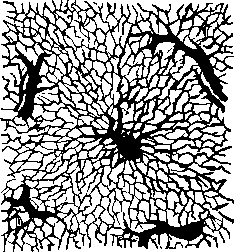122. The Liver (Figs. 57 And 78)
Description
This section is from the book "Animal Physiology: The Structure And Functions Of The Human Body", by John Cleland. Also available from Amazon: Animal Physiology, the Structure and Functions of the Human Body.
122. The Liver (Figs. 57 And 78)
The liver is much the largest gland in the body, between 3 and 4 lbs. in weight, and of remarkable complexity, both of structure and function. Its most obvious function is to secrete bile; but the bile is secreted less for the sake of its utility in digestion, than as a product resulting from certain complicated processes of blood-purification.
The liver lies beneath the diaphragm, with the greater part of its bulk on the right side, under cover of the ribs, and from its position is the organ most liable to compression and injury by tight-lacing. It has a right and left lobe, and is, in fact, a bilateral organ in all vertebrate animals. It even happens in a few fishes that these lobes are quite disconnected, forming symmetrically placed right and left livers. Before birth the liver bears a much larger proportion to the body than it does afterwards; and the bile which is at that time secreted by it accumulates in the intestine, to be expelled when the child is born, and is called meconium. Originally the liver occupies the whole of the upper part of the abdomen, and the left lobe is as large as the right; but this does not continue long; and in the adult, the left lobe is comparatively small, and falls considerably short of reaching the left side of the body.

Fig. 86. Hepatic Lobule, capillary network: radicle of hepatic Vein in the centre, and branches of portal vein at the circumference, together with two small twigs of hepatic artery.
The greater part of the blood sent to the liver enters it by the portal vein, and comes from the stomach, intestine, and spleen; but there is likewise a hepatic artery which nourishes the textures of the viscus; and the blood entering by this channel is afterwards conveyed to the capillaries of the portal system. The hepatic substance is arranged in minute lobules, each of which has ramifications . of the portal vein in its circum-" ference, and in its centre a radicle of the hepatic vein, by which the blood is carried from the liver into the vena cava. A rich network of small-meshed capillaries not only unites the branches of the portal and hepatic veins, but pervades the whole organ, passing continuously from one lobule to another. Only a few animals, such as the pig, furnish an exception to this rule, and have the hepatic lobules distinct.
When the blood-vessels are empty, a, section of liver under the microscope exhibits little else than a mass of nucleated corpuscles. These corpuscles, termed the hepatic cells, are somewhat flattened polyhedral bodies of an average diameter of 1/1000 of an inch, of a yellowish tinge, containing numerous the neck, where the origins of the nerves are further separated; and if it be made at a point midway between the origins of successive nerves, not only is it painless, but irritation of the lips of the wound produces no pain. From this it is concluded that the proper fibres of the cord, those not directly continuous with the nerves, are insensible to irritation, and that the pain in the dorsal region is occasioned by irritation to the fibres of the sensory nerve-roots as they pass in to the grey matter, some of them passing upwards and others downwards in their course to the posterior cornu, so that there are divided fibres in connection with the grey matter in both the lips of the wound. And not only are the fibres proper to the cord insensible to direct irritation, but so also is the brain. Slicing the brain away in experiments on animals is painless, and disease of the substance of the brain is painless, although inflammation of the membranes covering it is acutely painful, the membranes having nerves distributed in them. There is thus a very marked difference in the irritability of the fibres of the central nervous system and the peripheral nerves; it does not, however, follow that the active or impressed condition is not of the same description in both.
Continue to:
